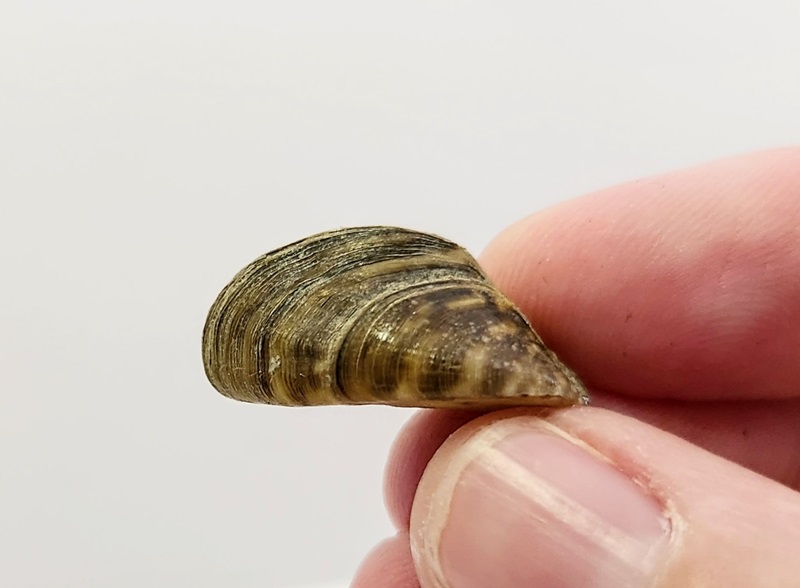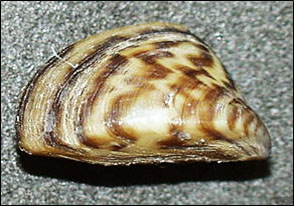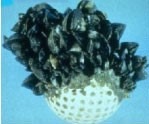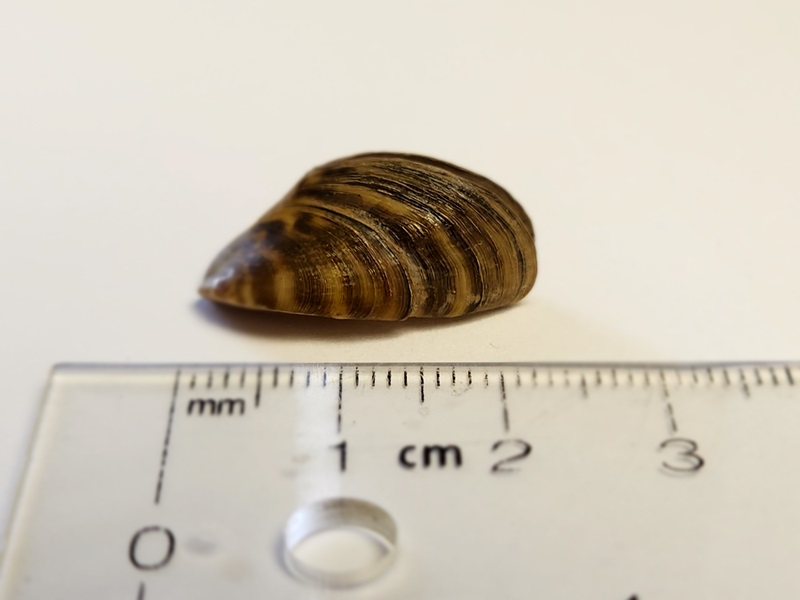Zebra Mussel
Dreissena polymorpha
Report it
If you think you have found an aquatic invasive species:
- do not return the species to the water
- take photos
- note:
- the exact location (GPS coordinates)
- the observation date
- identifying features
- contact us to report it
Invasive mussels infected moss ball products
Zebra and/or quagga mussels have been identified in moss ball products sold in stores in Canada. We urge everyone who may have purchased moss ball products in Canada or online to dispose of them responsibly. Learn how you can do so.
Learn about Zebra Mussels, including their identifying features, habitat, spread, impacts and our response.

Zebra Mussel
On this page
- Identifying features
- Where is the species invasive?
- Distribution
- Habitat
- Impacts
- Response
- Photo gallery
- Related links
Identifying features
Zebra Mussels (Dreissena polymorpha) are freshwater hinged mollusks. You can identify them by their:
- flat underside
- triangular shape
- varying zigzagged patterns of black or brown with white and yellow
- average size of 2 to 2.5 cm, reaching up to 4 cm long
The Zebra Mussel resembles the Quagga Mussel; however, the Zebra Mussel is smaller, more square, and narrower while the Quagga Mussel has a rounded underside.
If you think you have seen Zebra Mussels, report it.
Where is the species invasive?
Zebra mussels are invasive to all of Canada. As of 2022 in North America, Zebra Mussels have been found in:
- Lake St. Clair
- The Great Lakes
- The St. Lawrence River
- The Mississippi River watershed
- Lake Winnipeg, Red River, and Nelson River
- Saint John (Wolastoq) River watershed
As of 2020, Manitoba is the western-most province in Canada known to have been invaded by Zebra Mussels.
Distribution
Zebra Mussels are native to the Black and Caspian seas region in southeastern Europe.
Zebra Mussels entered the Great Lakes in the late 1980s through ballast water discharged from ships. Since then, they have spread through much of eastern Canada and the United States.
Habitat
Zebra Mussels are a freshwater species and will not survive in marine environments.
There are many ways Zebra Mussels can spread through Canadian waters. Their larvae (called veligers) are microscopic and float in water. Veligers will follow lake and river currents until they settle on a solid surface. This natural dispersal method means they can easily affect waterways connected to an invaded area.
Most importantly, Zebra Mussels can survive out of water for up to 18 days in high humidity. They can attach themselves to watercraft and be spread over land to uninvaded waterbodies. That’s why it’s important for water users to: Clean, Drain, and Dry their watercraft and/or equipment when leaving an invaded waterbody. Canadians are encouraged to check if the province they are in has recommended or legislated Clean, Drain, Dry methods.
Impacts
Zebra Mussels are filter feeders that attach themselves to solid surfaces. They breed very quickly, as females can release up to one million eggs each breeding season. After the eggs are fertilized, larvae (called veligers) emerge and are free-swimming for up to a month. The combination of these factors mean that Zebra Mussels can colonize in densities over 700,000 individuals per m2 on surfaces such as:
- boats
- docks
- rocks
- plants
- native mussels
Ecological Impacts
Zebra Mussels can have significant negative impacts on freshwater habitats by out-competing native species for food. This affects the composition of other communities within the ecosystem by:
- altering food webs by removing native species’ food sources, such as plankton
- affecting fish spawning areas by changing important substrates, which impacts the survival of fish eggs
- creating clearer water, which:
- allows sunlight to penetrate deeper
- increases the growth of submerged aquatic vegetation
- leads to toxic algal blooms as Zebra Mussels do not feed on toxic algae
- increases pathogenic bacteria, avian botulism, and localized anoxia
Zebra Mussels are especially harmful for native mussels, many of which are species at risk. They outcompete these species for food and will attach themselves to native mussels, suffocating them.
Socio-economic impacts
In Canada, Zebra Mussels cause millions of dollars in damage every year by clogging intake structures in power stations and water treatment plants as well as damaging watercrafts.
Response
Zebra Mussels are one of the six prohibited species under the federal Aquatic Invasive Species Regulations and cannot be imported into Canada. We work with the Canada Border Service Agency as well as provincial and territorial governments to prevent them from entering Canada through contaminated watercraft and aquarium products such as moss balls.
In Canada, most provincial governments lead on Zebra Mussel surveillance, monitoring, and control. Fisheries and Oceans Canada supports the early detection of Zebra Mussels in the prairies and in New Brunswick by using environmental DNA (eDNA) sampling in waters with no known invasion.
In Quebec, we work with local non-government organizations and environmental groups to monitor the St. Lawrence River for Zebra Mussels and other pelagic invertebrates.
In New Brunswick, we also work with local non-government organizations and environmental groups to monitor the Saint John River and other freshwater bodies in the province for Zebra Mussels. We work with our partners to educate and inform the public about the importance of cleaning, draining and drying all watercrafts and equipment before transferring them from one body of water to another.
Manitoba, Saskatchewan, and Alberta have programming for early detection and monitoring of Zebra Mussels as well as boat inspection and decontamination teams that prevent the spread of Zebra Mussels across inland waters in Canada.
Photo gallery

Zebra Mussel

Zebra Mussels attached to golf ball

Zebra Mussels attached to a boat propeller

Zebra Mussel
Related links
- Report an aquatic invasive species
- Government of Manitoba Agriculture and Sustainable Development
- Government of Saskatchewan Aquatic Invasive Species Prevention and Monitoring Program
- Government of Alberta Aquatic Invasive Species
- Government of Quebec Inspection and Cleaning of Boats and Equipment (in French only)
- Date modified: